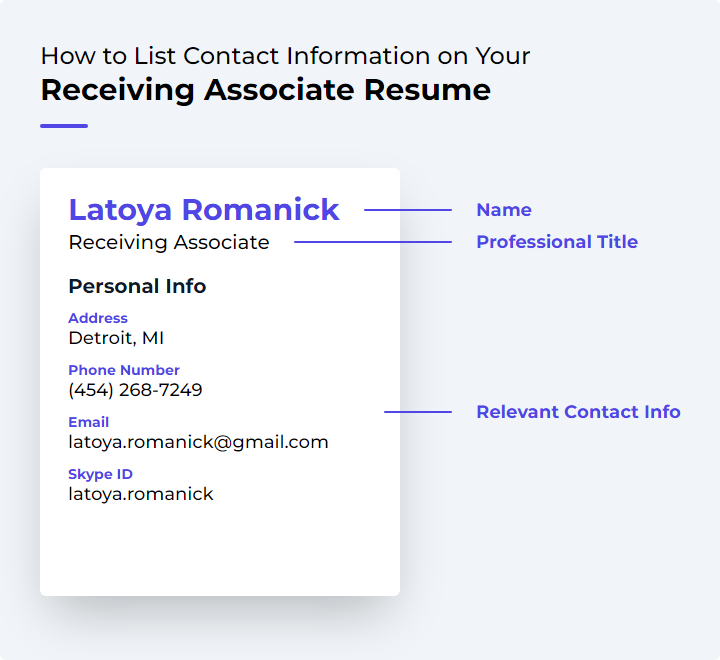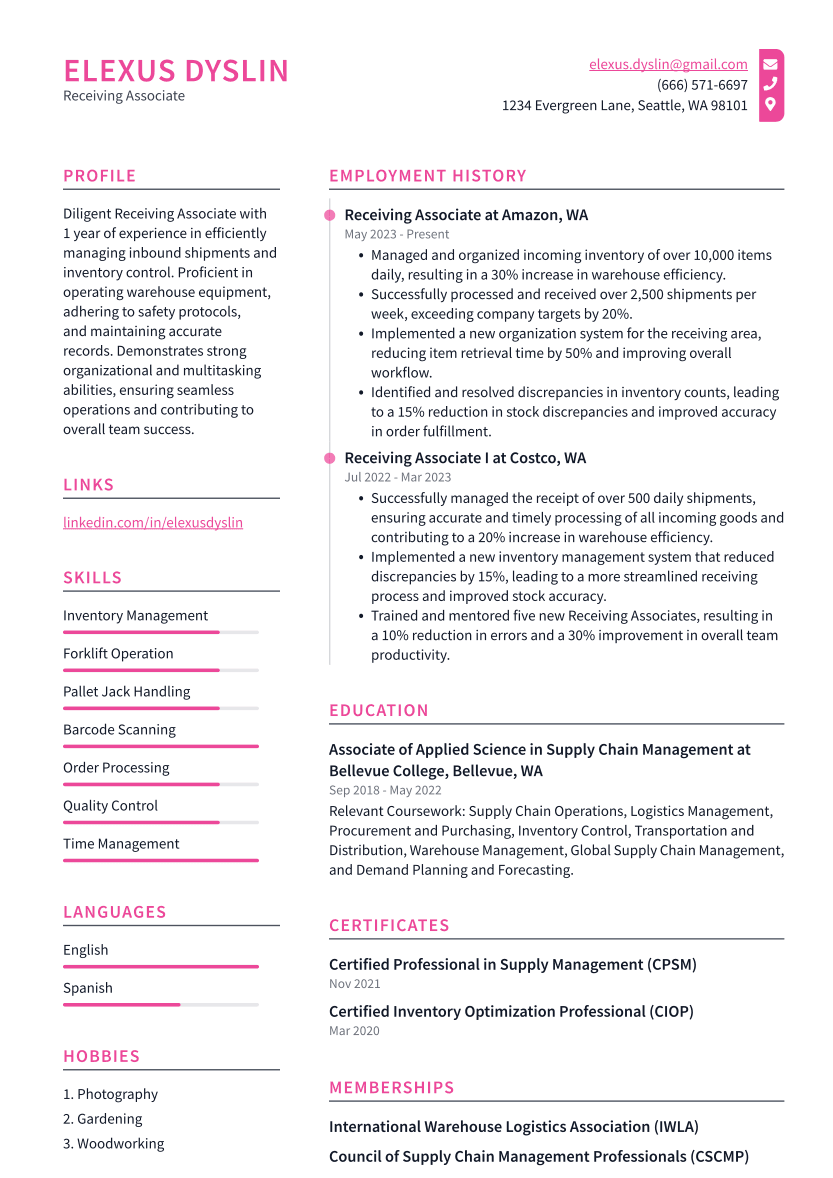Receiving Associate Resume Examples
Writing a great receiving associate resume is important because it is one of the first things a potential employer will see when they are considering you for a position. It is your opportunity to make a good first impression and sell yourself as the best candidate for the job.
Create your resume
Select from 7 professional resume templates
If you're looking for inspiration when it comes to drafting your own receiving associate resume, look no further than the samples below. These resumes will help you highlight your experience and qualifications in the most effective way possible, giving you the best chance of landing the receiving associate job you're after.
Essential Components of a Receiving Associate Resume
A Receiving Associate Resume is a critical tool that showcases an applicant's skills, experience, and qualifications for managing the receipt of goods in a retail environment. This role demands meticulous attention to detail, strong organizational abilities, and the capacity to manage multiple tasks simultaneously. The resume must effectively highlight these competencies, along with other essential skills such as inventory management, product inspection, record-keeping, and collaboration. The following sections will delve into the key elements of a Receiving Associate's resume, explaining the significance of each and what to include, as well as providing tips to make your resume stand out to potential employers.
1. Contact Information
The Contact Information section is crucial and should be prominently placed at the top of your resume. It must include your full name, home address, phone number (preferably mobile), and a professional email address. If applicable, you can also add links to professional social media profiles, such as LinkedIn, ensuring they present a professional image.
Avoid including personal details like marital status, age, or religion, as they are not relevant and could lead to discrimination.
First impressions matter, so ensure your contact information is accurate to facilitate easy communication for interviews or further job discussions.

2. Objective Statement
The Objective Statement sets the tone for your resume and should be concise, clear, and tailored to the position you're applying for. Highlight your career goals and alignment with the company's objectives, demonstrating your understanding of the role and your interest in it. Mention relevant skills and experiences, such as inventory control and organization, and any related experience in receiving or similar fields.
An effective objective statement can capture the attention of hiring managers and pique their interest in your qualifications. For example: "Eager to join XYZ Company as a Receiving Associate, bringing 5 years of inventory management expertise and exceptional organizational skills to enhance operational efficiency."
3. Work Experience
The Work Experience section provides a glimpse into your professional background. Start with your most recent position, including the company name, location, dates of employment, and job title. List your responsibilities and achievements using bullet points and action verbs.
Highlight any accomplishments, such as process improvements or recognition for excellent performance. If you have a diverse work history, emphasize transferable skills relevant to the Receiving Associate role.
This section is not just a list of past jobs but a showcase of how your experiences make you a suitable candidate for the position at hand.
4. Skills and Competencies
The Skills and Competencies section is where you list the abilities that make you fit for the job. Include organizational skills, attention to detail, physical stamina, computer literacy, communication skills, mathematical skills, problem-solving abilities, teamwork, time management, and knowledge of safety procedures.
These skills demonstrate your capability to perform effectively and contribute positively to the organization's operations.
5. Education and Certifications
Your Education and Certifications are essential for establishing your qualifications. While a high school diploma is often sufficient, additional education or certifications in logistics, business administration, or supply chain management can be advantageous. Include any relevant training or computer skills, as these are highly valued in today's digital workplace.
While not always mandatory, these qualifications indicate your commitment to the field and your initiative to enhance your expertise.
6. Relevant Achievements
The Relevant Achievements section allows you to highlight your successes in previous roles that are pertinent to a Receiving Associate position. Use quantifiable metrics to illustrate the impact of your achievements and include any awards or recognitions you have received.
This section should focus on your contributions and how they have benefited your previous employers, rather than just listing job duties.
7. References
The References section provides contacts who can attest to your skills, experience, and work ethic. Choose individuals who have directly supervised your work or collaborated closely with you, such as former managers or colleagues.
Always obtain permission before listing someone as a reference and provide them with a copy of your resume. Typically, include three to five references with their name, title or relationship to you, company name (if applicable), and contact information.
A well-prepared References section can be a deciding factor for hiring managers when considering two equally qualified candidates.
Remember, a well-crafted resume is your ticket to securing an interview and advancing your career as a Receiving Associate. Ensure each section is thoughtfully prepared and reflects your best professional self.